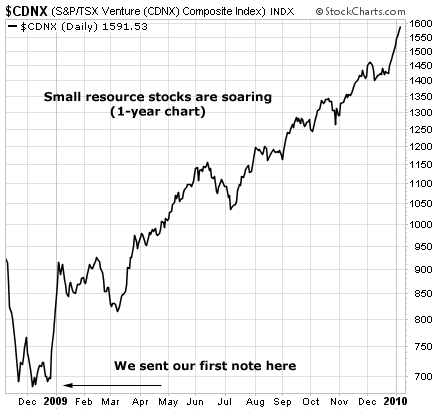| Home | About Us | Resources | Archive | Free Reports | Market Window |
The No. 1 Advantage You Have Over the Average InvestorBy
Saturday, January 9, 2010
Right now, two severe problems are affecting the average investor.
These problems will doom the average investor to mediocrity at best, and a lifetime of financial problems at worst. One problem is extreme, rosy optimism. While I'm a "glass half full" guy, years of investment experience has taught me that wild optimism is a handicap when it comes to investing. It blinds you to risk. It drives you to pay more for assets than they're actually worth. Take one of the most comprehensive investor sentiment studies, the American Association of Individual Investors Sentiment Survey. This survey tracks the bullishness and bearishness of 140 different investment newsletters. The survey is now 49% bullish and just 15% bearish. That's the highest bullish rating since right before the crash of 1987, which occurred after a two-year, 150% stock market rally. Investors are more bullish today than they've been in over two decades. The last time investors were this bullish, the Dow Jones Industrials Average lost 22% in one day. Big one-day crashes are rare, but you should be wary of most stocks right now based on peaking investor sentiment alone. Because this peaking optimism produces excessive valuations... The U.S. stock market, as measured by the Wilshire 5000 Index, is selling at 32.5 times earnings and yielding 1.8% in dividends. You're not going to make any money buying stocks north of 30 times earnings. For the market to return to its historical average valuation, earnings would have to almost double, an event even rarer and less likely than a 22% one-day drop in the market. Even the greatest World Dominator businesses are rarely worth more than 30 times earnings, even when they're taken private by the most well-informed competitors in their industry. Mars bought Wrigley's for about 32 times trailing free cash flow, and that was the highest-priced deal I've seen for a World Dominator stock. The entire market isn't made up of unassailable Wrigley's-like franchises. Most public companies will never be worth your time or money. They're low quality and so hard to value, you shouldn't buy them at any price. I'm not just talking about the Wilshire 5000, either. Pick any group of 5,000 stocks anywhere in the world, and they'll deliver lousy returns (if any at all) to anyone who buys them at 32.5 times earnings or higher. The mistakes of excessive optimism fall hard upon people with the next problem, which is impatience. Thirty years ago, the average holding period for stocks trading on the New York Stock Exchange was five years. Today, the average holding period for NYSE-traded stocks is just six months. On average, investors are willing to wait just six months for their investment results to arrive. That's crazy. Compounding takes time. Anybody who can't wait more than six months for profits to arrive in their own good time can't be interested in making money in stocks. Anybody who can't hold stocks through the market's ups and downs is never going to make money in stocks over time. The growing impatience of increasingly overconfident investors is bad for the thundering herd, but it's great for you and me. It offers us a major source of competitive advantage over other investors, and at a much lower price today than others have had to pay for it in the past. But you don't pay for it with money. You pay for it with time... Thirty years ago, we had to wait more than five years to acquire and exploit the advantage of patience. Today, the wait has contracted to just six months. It's a bigger advantage today, too. An extra year of waiting is a bigger advantage relative to a six-month average holding period than it is relative to the five-year average holding periods of 30 years ago. When you waited an extra year back then, it was 20% longer. If you wait an extra year today, you're waiting 200% longer than the average investor. So the advantage of waiting the same amount of time is 10 times greater today. There's virtually no competition for patient, long-term investors. Nobody is trying to outwait the other guy. The scrummage for short-term profits is insane. It makes no sense to place a low-probability bet in a highly competitive market, when it's so easy to place a much higher-probability bet in a market virtually devoid of competition. Long-term investing is more out of favor than ever. Patience in January 2010 is as cheap as risk was in March 2009. So... how do you buy patience? Well, if the way to buy risk was to buy risky stocks, then the way you buy patience is to buy stocks you are highly confident you'll be able to hold for the long term. This means buying and holding stocks I've highlighted in DailyWealth many times: dominant companies that will be dominant 10 years from now, like Microsoft and Altria. These stocks are much cheaper than the overall market. I'm devoting much of my time to analyzing these sorts of companies for the benefit of my readers. I hope you're doing the same. Good investing, Dan Ferris P.S. I've devoted a special section of the Extreme Value portfolio to the best deals in World Dominating stocks today. I will shout from the rooftops that this is THE ONLY list of stocks you need to immediately build a fortress-like portfolio in the coming years. To learn more about Extreme Value, click here.
Further Reading:
Now Is a Once-in-a-Lifetime Opportunity for Income Investors Market NotesMOONSHOT
|
In The Daily Crux
Recent Articles
|


